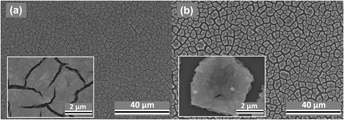Crossref Citations
This article has been cited by the following publications. This list is generated based on data provided by
Crossref.
Chen, Zhaoxi
Townsend, James
Aprelev, Pavel
Gu, Yu
Burtovyy, Ruslan
Luzinov, Igor
Kornev, Konstantin G.
and
Peng, Fei
2018.
Magnetic Submicron Mullite Coatings with Oriented SiC Whiskers.
ACS Applied Materials & Interfaces,
Vol. 10,
Issue. 14,
p.
11907.
Mouche, P.A.
Ang, C.
Koyanagi, T.
Doyle, P.
and
Katoh, Y.
2019.
Characterization of PVD Cr, CrN, and TiN coatings on SiC.
Journal of Nuclear Materials,
Vol. 527,
Issue. ,
p.
151781.
Lai, Hsin‐Yu
and
Hsiang, Hsing‐I
2019.
Dense CIGS films obtained by blending submicron‐sized particles with nanoparticle suspensions using a non‐vacuum process.
International Journal of Applied Ceramic Technology,
Vol. 16,
Issue. 3,
p.
974.
Hong, Yuzhe
Chen, Zhaoxi
Lei, Jincheng
Zhang, Zhao
Xiao, Hai
Kornev, Konstantin G.
Bordia, Rajendra K.
Tong, Jianhua
and
Peng, Fei
2020.
Direct inkjet printing of mullite nano-ribbons from the sol–gel precursor.
Journal of Sol-Gel Science and Technology,
Vol. 95,
Issue. 1,
p.
66.
Noh, Jihun
Bai, Qingshun
Shen, Rongqi
and
Kim, Dongsik
2021.
Laser-induced shock wave sintering of silver nanoparticles on flexible substrates.
Applied Surface Science,
Vol. 546,
Issue. ,
p.
149097.
Zhu, Zhennan
Zhang, Jianhua
Ning, Honglong
Yang, Yuexin
Xu, Wei
Yao, Rihui
Cao, Xiuhua
Tang, Biao
Lu, Xubing
and
Peng, Junbiao
2021.
Binary Solvent Systems for Piezoelectric Printing Crack-Free PAM/ZrOx Hybrid Thin Films through Nanostructure Modulation.
Langmuir,
Vol. 37,
Issue. 19,
p.
5979.
Gonçalves, Gabriel Cardoso
Gimeno, Florian
Dicharry, Christophe
Allouche, Joachim
Charrier-El Bouhtoury, Fatima
and
Dupin, Jean-Charles
2022.
Design of Sol–Gel Hybrid Bio-sourced Lignin/Silica Hydrophobic Nanocomposites through a Dip-Coated Evaporation-Induced Self-Assembly Method.
ACS Sustainable Chemistry & Engineering,
Vol. 10,
Issue. 38,
p.
12783.
Johari, Nur Dalilah
Rosli, Zulkifli Mohd
and
Juoi, Jariah Mohamad
2022.
Effect of heat treatment temperature on the structural, morphological, optical and water contact angle properties of brookite TiO2 thin film deposited via green sol–gel route for photocatalytic activity.
Journal of Materials Science: Materials in Electronics,
Vol. 33,
Issue. 18,
p.
15143.
Braga, Antônio Vitor de Castro
do Lago, Dalva Cristina Baptista
Lima, Eduardo Rocha de Almeida
and
de Senna, Lilian Ferreira
2023.
The effects of aging time on the sol-gel properties and its relationship with the anti-corrosive performance of coatings prepared by sol-gel dip coating.
Journal of Materials Research and Technology,
Vol. 27,
Issue. ,
p.
5594.
Moradi, Salar
Beidokhti, Sahar Mollazadeh
Khaki, Jalil Vahdati
S. Hosseini, Morteza
and
Kiani Rashid, Alireza
2024.
The effect of synthesis parameters on the adsorption capacity of Cu+2 ions of mullite containing polymer composites.
Journal of the Australian Ceramic Society,




